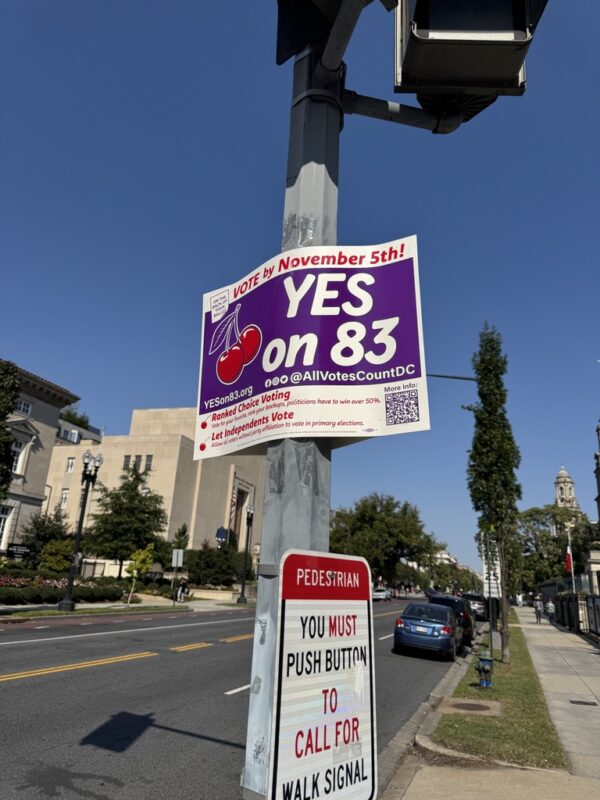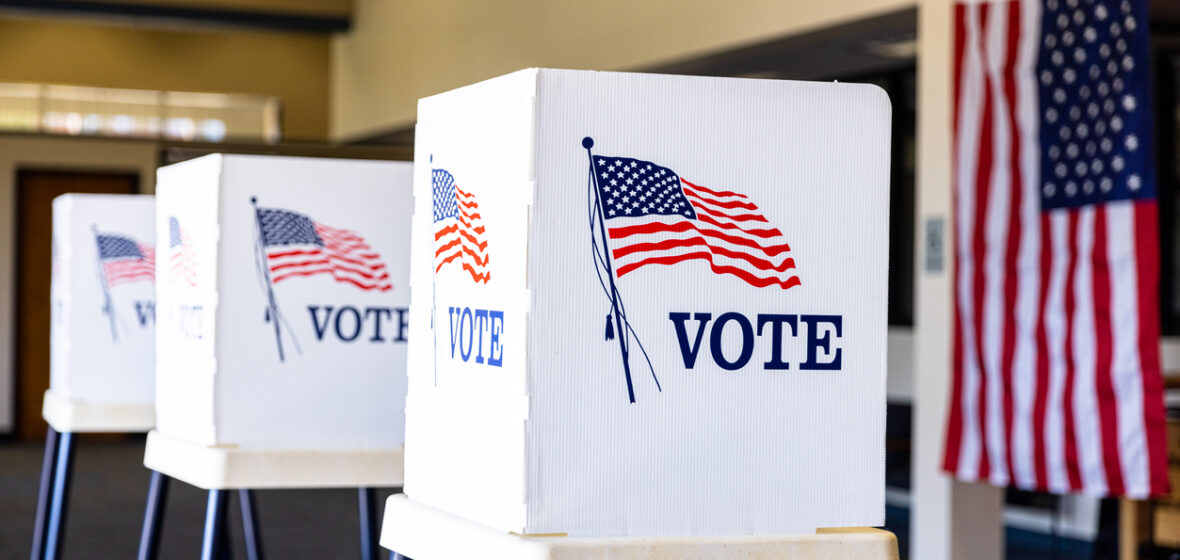The race for President captures all the headlines. But come 5 November, Americans across the country will be asked to cast their ballot in thousands of elections at federal, state and local levels.
America is often said to be the global capital of elections: a place where tens of thousands of public officials whose positions range from the utmost important to the mundane to the downright obscure are elected by the people instead of by the government.
This method of direct democracy can be laudable, though it often results in toxic, expensive campaigns and partisan clashes between polarising candidates whose job should be to make independent and non-partisan decisions in the best interests of their office.
A typical ballot paper on election day will have between 10 and 25 elections. This year, in 34 states it will include an election for the US Senate, and in all 435 federal districts it will include an election for the US House of Representatives.
Eleven states will hold races for governor, 10 for attorney-general and state treasurer, seven for secretary of state, 44 for state legislative chambers, 33 for state supreme court and court of appeal judges, and dozens more for a range of state-wide elected officials including auditor, superintendent of public instruction, agriculture commissioner, insurance commissioner, land commissioner, labor commissioner, mine inspector and tax commissioner.
At the local level, there will be races for mayors, sheriffs, county supervisors and county auditors, plus elections for members of the local boards of education and elections, as well as tribal positions throughout Native lands.
Finally, as of October 6, there were set to be 160 statewide ballot measures (also known as referendums) in 41 states.
Here are some of the most important elections up and down the ballot to watch on election day.

Control of the Senate and the House
A future President Donald Trump or Kamala Harris requires a Republican or Democratic trifecta (control of the Presidency, Senate and House) to pass the bulk of their legislative agenda. Some decisions can be made with executive action, and others will have bipartisan support through Congress, but in this highly partisan era most of the candidates’ proposed laws will attract support only from members of their party.
A President needs 50 of the 100 Senate seats to control the chamber. Democrats (and Independents who caucus with them) currently have 51, but West Virginia — whose maverick Democratic Senator Joe Manchin is retiring — will fall to the Republicans. If Harris defeats Trump, winning the Senate will require retaining all other Democrat-held seats, including in the battleground states of Nevada, Arizona, Wisconsin, Michigan and Pennsylvania, and even in the solidly Republican states Ohio and Montana.
Strikingly, the Democratic candidates lead by significant margins in almost all of these states — but almost all is not enough. The Democratic Senator for Montana, Jon Tester, is outperforming Harris’s numbers by more than 10% but he still trails to Republican Tim Sheehy and is likely to lose. That would mean the Republicans would take control of the Senate unless the Democrats can pull of a surprise upset in Texas (against the very unpopular Ted Cruz) or Florida (against the somewhat unpopular Rick Scott). The Democrats are piling more money into both of these states; though they lean red, the Senate races are closer than expected. Ohio, Montana, Florida, Texas: ones to watch on election day…
A majority in the House is just as important as control of the Senate. 218 seats are required; the Republicans currently have 220.
According to most forecasts, 206 House districts are rated as safe, likely or lean Democrat, and 207 the same for Republicans. There are 22 ‘toss-up’ seats across 14 diverse states that will decide control of the House for the next two years. Pay close attention to California 41st, New York 17th and Oregon 5th to see if the Democrats can unseat the Republican incumbents. If Democrats win all three, expect them to reclaim control of the US House of Representatives.
Key state races
Of the 11 races for state governors this year, just one has a chance to flip from one party to the other: New Hampshire, whose popular Republican leader is retiring, handing Democrats an even chance to take over. While Republicans were previously thought to have had a solid chance of reclaiming North Carolina following the retirement of popular Democrat Roy Cooper, its scandal-plagued candidate Mark Robinson — who was recently discovered as being the owner of an account on the porn website “Nude Africa” where he referred to himself as a “Black Nazi” and spoke favouringly of slavery — is now condemned to heavy defeat. The most interesting thing to watch in North Carolina will be whether Trump can earn enough ‘ticket-splitters’ to hold on to the state’s electoral 16 electoral college votes.
State Supreme Courts are attracting more attention than ever. Since the US Supreme Court overturned Roe v Wade, it has become the job of the states — and by extension, their Supreme Courts — to decide whether abortion is legal in their jurisdiction. In Michigan and Montana, the Courts’ liberal majorities have protected abortion measures, and they have also made a series of consequential decisions blocking harsh sentencing practices, supporting voting rights and defending the environment. Both courts could flip in November.
In Kentucky, where a conservative majority denied attempts to challenge the state’s near-total abortion ban, and in Ohio, where a Republican majority dismissed challenges to legislative maps as unconstitutional partisan gerrymandering, control of the court is also up for grabs.
American is a federation like Australia. The states have enormous power to make their own laws, even less encumbered by the federal government than down under. And unlike in Australia — where the independent Australian Electoral Commission draws and re-draws federal electorate boundaries — in America this is the job of the states.
State legislative control is thus vital, and among the chambers where both parties stand a chance, control is at stake in six: the Arizona House and Senate, where Republicans narrowly run both chambers; the New Hampshire House, also with a slim Republican majority; and the Michigan, Pennsylvania and Minnesota Houses, all of Democrat control. In addition to making laws on crime, taxes, education and any number of central policies, state chambers now legislate on abortion. These six chambers will be closely watched on November 5.
Ballot initiatives
In most US states, the people have the power to bypass the government and rule on policies themselves by changing the state’s constitution through an election-day referendum.
Getting a question on the ballot is difficult — activists must gather a fixed number of signatures (usually in the many thousands) in support of the measure and meet strict timing requirements — but once it is there, assuming it receives majority support (some states require a 60% majority), nothing further is needed for the law to stand and withstand repeal without a further referendum.
In recent years, many activists have used ballot initiatives in states with conservative governments to legalise recreational marijuana, enable incarcerated people to vote, and since last year’s Dobb’s decision, enshrine the right to an abortion in the state constitution. In California, union activists sought to pass a ballot measure that would mandate rideshare drivers be classified as employees, receiving all the entitlements on which independent contractors miss out. But a well-funded campaign by Uber and Lyft helped reject the measure.
On November 5, 2024, voters in 10 states will decide on a ballot measure that would provide for state constitutional rights to abortion, while voters in Nebraska will vote on whether to limit the time for which abortions can be performed.
Among the other high-profile referendums, in Colorado, Idaho, Nevada and Oregon, voters will decide on whether to adopt ranked-choice voting (preferential voting); in Alaska, California, Massachusetts and Missouri, voters will decide on whether to raise the state’s minimum raise; and in Florida, North Dakota and South Dakota, voters will decide on whether to legalise marijuana.
In time of ideological entrenchment, ballot measures are one of the most effective ways to bypass legislative gridlock and get stuff done. They will be among the most closely followed races on election day.




